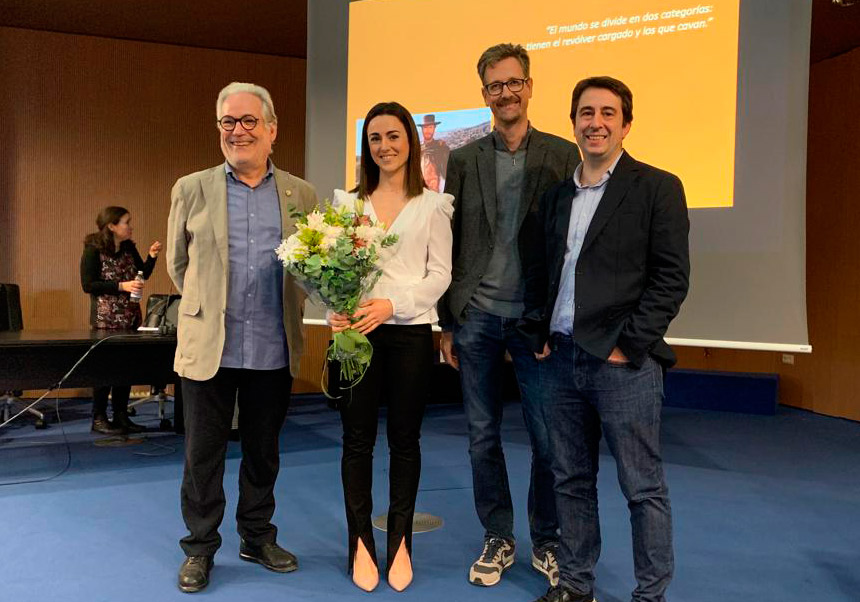Users
Social media
- More details here...
- Address
Parc Científic de la Universitat de València C/
Catedrático Agustín Escardino, 9
46980 Paterna (Valencia) Spain - Email:
iu.i2sysbio@uv.es - Phone:
(+34) 963544810
- Address
Links
Esther Molina-Menor defends her thesis on bioprospecting of dry and irradiated environments

Investigation & Education
Thesis
Esther Molina-Menor defends her thesis on bioprospecting of dry and irradiated environments

This thesis, directed by Manuel Porcar, Albert Quintana and Juli Peretó, studies the microbial diversity of dry and irradiated environments, explores several approaches to increase the number of strains of potential interest and investigates some biotechnological and biomedical applications. The results of the research have been published in the journals Microbial Biotechnology, Frontiers in Microbiology, Microorganismes, International Journal of Systematic and Evolutionary Microbiology, Scientific Reports and Frontiers in Bioengineering and Biotechnology. The thesis was defended on November 3, 2023.
Bioprospecting is the search for microorganisms, or their parts, to develop biotechnological tools. Extremophilic environments, such as highly irradiated and dry ones, harbor microorganisms of interest from a biotechnological point of view. The work described in the thesis "Light and Drought. Bioprospecting the microbiota of highly irradiated and dry environments" aims to characterize the microbial profiles associated with natural and artificial surfaces subjected to irradiation (the rocky Mediterranean coast, the Tabernas desert and hospital UV light cabins), through a holistic strategy that includes culture-independent and culture-dependent techniques. Emphasis has been placed on improving the recovery of maximum microbial diversity and the description of new taxa by combining simple cultivation strategies. In parallel, the biotechnological and biomedical applications of these microorganisms have been investigated. In addition, the use of alternative solid-state fermentation culture configurations has been studied using 3D matrices.
The combination of culture media and incubation conditions has led to the isolation of a high number of different genera, potentially new taxa and biotechnologically relevant strains, as demonstrated by the description of three new species of Kineococcus and two of Belnapia. In addition, next generation sequencing (NGS) allowed us to determine differences and similarities between the places studied. Specifically, the communities in the three highly irradiated environments were dominated by members of Pseudomonadota, Actinomycetota and Bacteroidota. Furthermore, NGS revealed that the low diversity found in the collection of isolates from the Mediterranean rocky coast was influenced by culture methods and PCR performance. Furthermore, genera such as Hymenobacter, Rubellimicrobium, Paracoccus and Corynebacterium were abundant in the NGS but were completely absent in the collections.
In a standardized approach to microbial growth under conditions of low water activity, the design of 3D printed solid matrices aimed to study whether these structures can influence the growth of yeasts and their impact on biotechnology. The growth of Saccharomyces cerevisiae revealed that the 3D matrices dramatically promoted cell yield compared to equivalent static cultures and appeared to favor alcoholic fermentation. In addition, highly differentiated proteomic profiles were also obtained that indicated drastic metabolic adjustments.
Finally, the antioxidant potential of the strains isolated from the Mediterranean supratidal zone was evaluated by in vitro and in vivo assays. Furthermore, in collaboration with the Mitochondrial Neuropathology group of the Autonomous University of Barcelona, the antioxidant potential of a strain of Micrococcus luteus, a carotenoid-producing bacteria, was tested in a murine model of a human mitochondrial disease (Leigh Syndrome). Although the administration of a microbial preparation had no beneficial effects on the diseased mice, serendipity led us to identify that maltodextrin (used as a cryoprotectant) was responsible for a reduction in neuroinflammation, an increase in lifespan and a variability in the abundance of Akkermansia spp. in the intestine of mice.
Esther Molina-Menor carried out her doctoral research in the Biotechnology and Synthetic Biology group under the supervision of Manuel Porcar, researcher at the Universitat de València at the Institute of Integrative Systems Biology I2SysBio (UV-CSIC), Albert Quintana, associate professor at the Universitat Autònoma de Barcelona and researcher at the Institut de Neurociències (INc, UAB) and Juli Peretó, professor at the UV and researcher at I2SysBio (UV-CSIC). During the development of the project Esther Molina-Menor has enjoyed a contract within the University Teacher Training Program (FPU, Ministry of Universities) and has carried out research stays at the Max Plank Institute for Terrestrial Microbiology (Marburg) and at the INc (UAB). The examining board was made up of Carles Pedrós-Alió (CSIC), Rosa Aznar Novella (UV) and Juana María Navarro Llorens (Complutense University of Madrid), who rated the thesis as outstanding.


